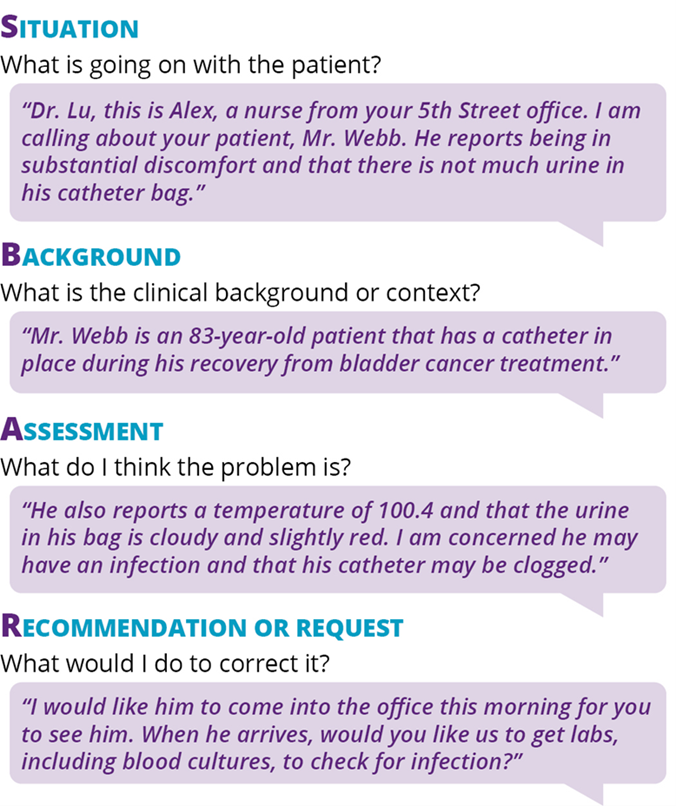How SBAR Improves Clinical Communication Among Healthcare Teams

Effective clinical communication is essential for ensuring patient safety and positive outcomes. A consistent and structured format for messages and conversations can help improve communication between healthcare professionals.
The SBAR framework is a standardized system that helps care teams share critical information about patients. By having a structured communication system in place, clinicians and other providers can communicate clearly with one another about the status of their patients.
In this article, we’ll discuss how SBAR improves clinical communication. By the end, you will understand how this framework can improve communication within your organization.
What is SBAR?
The SBAR framework is a widely used communication tool in healthcare that helps clinicians and other healthcare professionals share critical patient information in a structured and standardized way. The framework has four key components, each with its own significance.
-
Situation: Present a concise overview of the patient's current situation, including relevant medical history, chief complaint, vital signs, and any immediate concerns.
-
Background: Provide contextual information about the patient, such as their medical history, recent events, relevant laboratory results, or medications they are currently taking.
-
Assessment: Offer a clinical assessment or interpretation of the situation, including an analysis of the problem and potential causes.
-
Recommendation (or request): Suggest recommendations or actions to be taken based on the situation and assessment. This could include orders for treatment, diagnostic tests, or consultations with other specialists.
SBAR is an excellent method of communication that minimizes the risk of miscommunication or missed information during patient hand-offs. It ensures that essential information is communicated consistently and clearly among professionals.
 “The SBAR communication framework is commonly used in clinical communications within hospitals, but it has evolved beyond its original intent and is now used for many different types of communications in healthcare,” said Todd Thompson, Director of Operations at Backline by DrFirst. “Any healthcare organization can implement this system to improve their communication.”
“The SBAR communication framework is commonly used in clinical communications within hospitals, but it has evolved beyond its original intent and is now used for many different types of communications in healthcare,” said Todd Thompson, Director of Operations at Backline by DrFirst. “Any healthcare organization can implement this system to improve their communication.”
Benefits of Implementing SBAR in Your Healthcare Organization
Implementing the SBAR framework in a healthcare organization offers numerous benefits to both healthcare professionals and patients.
Improved Patient Safety
Medical errors have severe consequences for healthcare organizations. A significant amount of errors arise from a lack of communication or misunderstandings. SBAR facilitates clear and concise communication among healthcare professionals to help ensure critical information about patients is accurately conveyed, leading to better patient outcomes and safety.
SBAR can also help mitigate risks and reduce liability for healthcare organizations. Clear documentation of patient information and communication exchanges can serve as evidence of due diligence and adherence to best practices in patient care.
Empowered Staff Lead to Improved Patient Outcomes
Having a reliable communication network is crucial for empowering healthcare professionals to communicate confidently and assertively, especially in high-pressure or challenging situations. Utilizing the Situation-Background-Assessment-Recommendation (SBAR) method provides a clear and concise way to communicate critical information or advocate for patient needs, resulting in better patient outcomes and experience.
Enhanced Clinical Collaboration
SBAR encourages interdisciplinary collaboration by providing a structured format for communication among healthcare team members. This collaboration enhances teamwork, coordination, and the exchange of expertise, ultimately leading to better patient care and outcomes.
SBAR also contributes to the continuity of care by ensuring relevant information about patients is accurately documented and shared between healthcare providers. This continuity is essential for seamless transitions between different care settings or providers.
An Example of the SBAR Framework in Action
So, what does the SBAR framework look like in action? The image below depicts an example of the SBAR framework being used on the Backline by DrFirst platform.

As you can see, communication can be short and sweet but still gives the recipient enough information to know the situation, background, assessment, and recommendation of the sender. It reduces the likelihood of prolonged exchanges that could lead to confusion, inefficient use of time or muddled exchanges of information.
Another example from the Agency for Healthcare Research and Quality (AHRQ) suggests phrasing a conversation with another team member like this:

The SBAR framework is adaptable to the needs and preferences of the healthcare organization; not every organization uses it the same way. The goal is to have consistency within your organization. However, it is recommended to specifically write out S, B, A, and R (as shown above) or say the actual words to communicate even more clearly.
Overcoming Implementation Barriers
With any new procedure, you may face barriers in the implementation. Overcoming these barriers is essential to successfully integrate SBAR and maximize its impact on patient care.
Perhaps the biggest barrier is resistance to change. Healthcare professionals are used to their routine and a new procedure can be met with resistance. To help clinicians embrace new techniques, start with these strategies:
-
Start small and strategically: Enlist a few select members of your team to be the first to try the new process. Gain feedback on what they like and dislike about SBAR.
-
Select Change Campions: Change champions can help drive buy-in and adoption. Engage stakeholders from the outset by involving them in the development process of the new policies.
-
Provide training: Clinicians don’t have time to learn a complicated tool or process. Consider how you can make it easy for them to learn and adapt.
-
Communicate the benefits: Clinicians want to know how SBAR will benefit them and not cause extra work. Clearly explain the benefits and show them how SBAR can improve their workday and patient experience.
-
Require adoption: Inconsistent adoption will only lead to more frustration and confusion. Once the kinks are ironed out, ensure communication changes are ingrained in protocols and are accepted best practices across the team.
The SBAR framework can be a powerful tool for healthcare professionals to communicate clearly and efficiently with one another. Through its structured approach, SBAR enables healthcare professionals to effectively convey critical information, facilitating interdisciplinary collaboration and streamlined decision-making processes. As healthcare organizations continue to prioritize communication excellence, integrating SBAR becomes a strategy for overcoming communication barriers and promoting a culture of transparency and accountability.
If you’re wondering how SBAR and Backline by DrFirst work together, schedule a consultation. We’d be happy to show you a demo.





